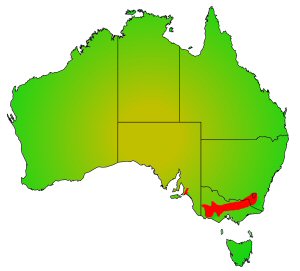Obscure galaxias facts for kids
Quick facts for kids Obscure galaxias |
|
|---|---|
| Conservation status | |
| Scientific classification | |
| Genus: |
Galaxias
|
| Species: |
oliros
|
The obscure galaxias (scientific name: Galaxias oliros) is a type of freshwater fish. It belongs to a group called the Mountain Galaxias complex. This fish is found in Australia.
Contents
About the Obscure Galaxias
The obscure galaxias looks similar to other fish in its group. It has a long, tube-shaped body. Most obscure galaxias are about 7.5 to 9 centimeters (3 to 3.5 inches) long. The longest one ever found was about 13.3 centimeters (5.2 inches). Its body is a bit flat on the sides, especially near its tail.
Body Shape and Fins
The top of its body curves smoothly from its neck to its tail fin. Its belly also curves, but less steeply. The part of its body just before the tail fin is quite thin and flat. Its head is a medium size, wider than it is deep. When you look from the side, its head looks a bit like a wedge. The fish has fairly large eyes that are set high on its head. Its mouth is at the end of its snout and is a medium size. The lower jaw is a little shorter than the upper one.
The fins of the obscure galaxias are thick at their base. The anal fin has a long base, while the dorsal fin (on its back) has a short base. Both fins are rounded. The anal fin is usually 10 to 20 percent longer than the dorsal fin. The front edge of the anal fin is usually about halfway along the dorsal fin's base.
Its pelvic fins are medium-sized and low on its body, about halfway along its length. The anal fin is positioned halfway between the pelvic fins and the tail. The pectoral fins, which are behind its gills, are medium-sized and rounded. They are low on the body, with their top edge even with or slightly higher than the back of its mouth. The tail fin is moderately long and slightly forked. It is usually longer than the thin part of the body before the tail. The obscure galaxias also has medium-sized flaps on its tail section. These flaps can extend forward to the back of the anal fin.
Colors and Patterns
The obscure galaxias is mostly olive green to grey-brown on its back and sides. This color extends over its head and snout. The color fades to cream, white, or silvery below its middle line and on its belly.
Its body has a pattern of small to medium-sized dark blotches. Many of these blotches join together to form uneven vertical bands. These markings are closer together on its upper body, including its neck. However, they are not on its head or snout, and sometimes they are very faint.
Sometimes, a row of copper or gold spots runs along its upper body from its neck to its dorsal fin. Occasionally, you might see small gold flecks scattered over its head and snout. The gill covers are see-through and have a large gold, silver, or turquoise patch. Its fins are light grey to olive and also see-through.
Where the Obscure Galaxias Lives
The obscure galaxias can be found at many different heights, from sea level up to 600 meters (about 2,000 feet). It lives in the Murray River system in Victoria and southern New South Wales. You can also find it south of the Great Dividing Range in western Victoria. This includes all the rivers that flow into the Wimmera River. It is also in several rivers that flow into the Murray River within the Mount Lofty Ranges in South Australia.
This fish is also found in rivers that flow to the coast in western Victoria. These include the Corangamite Basin, the Hopkins River, and even in Mosquito Creek, which is part of the Bool Lagoon area in South Australia. Additionally, the obscure galaxias lives very close to the sea in the Merri River and the Darlot/Fitzroy River systems in western Victoria.
Habitat
The obscure galaxias mostly lives in the lower parts of rivers and streams, from lowlands to foothills. It can be found in many different types of waterways. These include clear or cloudy, medium to large rivers (4 to 20 meters or 13 to 65 feet wide). It also lives in smaller creeks (0.5 to 4 meters or 1.6 to 13 feet wide) that flow gently or faster. You can also find it in side channels (anabranches), oxbow lakes (billabongs), and sometimes in wetlands.
Young fish often stay in shallow, fast-flowing areas around the edges of deeper pools. Adult fish prefer deeper pools, which can be 10 to 120 centimeters (0.3 to 4 feet) deep, and more open areas. They usually hide among thick water plants or woody debris like fallen branches. However, sometimes they can be seen in open water or near the surface. These fish can be very common in swamps.
Life Cycle and Reproduction
The obscure galaxias spends its entire life in freshwater. It can handle many different water conditions. For example, it can live in very cloudy or salty pools. It can also survive in still water with a lot of decaying plant material.
Spawning, which is when the fish lay eggs, usually happens from late May to early July. Sometimes, it can happen as late as August. The eggs are quite small, about 0.9 to 1.0 millimeter (0.035 to 0.039 inches) in size. Female obscure galaxias lay many eggs compared to other fish in their group. For example, one female that was about 10.5 centimeters (4.1 inches) long was recorded laying 2,057 eggs!
Conservation Status
The obscure galaxias is listed as "Least Concern." This means it is not currently at high risk of becoming extinct.
Usefulness to Humans
People do not usually fish for the obscure galaxias because it is quite small.



